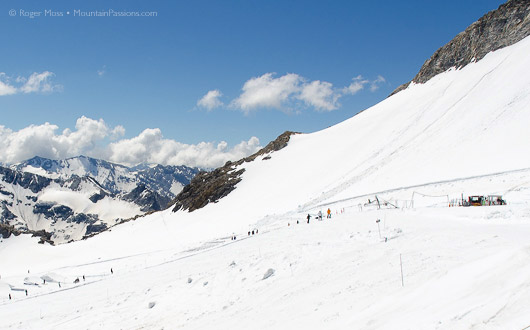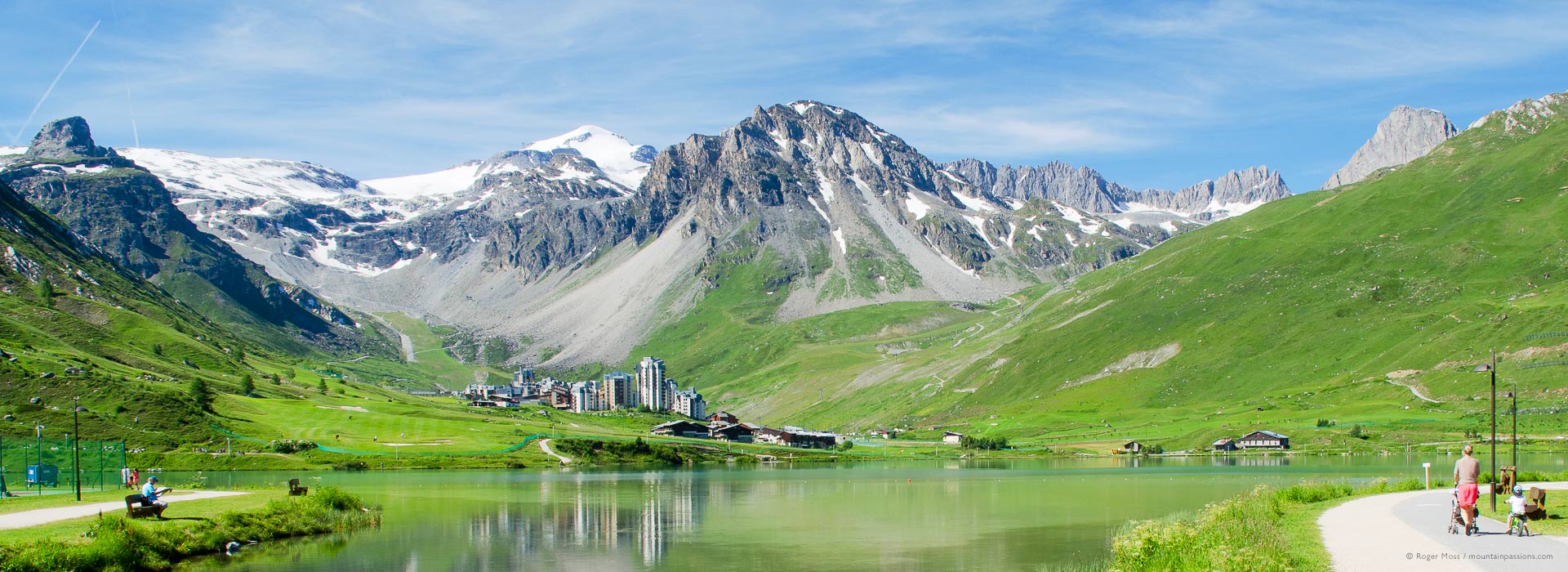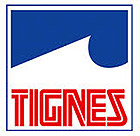Insight: Tignes

Summer in Tignes
As you’ll see from our Tignes ski resort review, we came to feel quite at home here during the ski season but had no idea how it might look and feel once grass and wild flowers had replaced snow and piste markers on the mountainsides. Experience has taught us, though, that just about anywhere in France which possesses a good-sized lake and a generous supply of tourist accommodation just has to be worth seeing. We headed off in mid-July to do just that.
Our base for a week’s stay is an apartment at Le Télémark, in Tignes Le Lac – a good choice, as it turns out, not least for the hypnotic views which greet us each morning from our balcony. To our left are the wild peaks of the Réserve Naturelle de la Grande Sassière, and the Franco-Italian border, while ahead and much closer are the high-rise apartment blocks of Le Lavachet. To our right, shimmering in the far distance, is the Glacier de la Grande Motte, whose cable-car climbs and descends like a spider patiently constructing a web.

Chalets and apartments of Le Lavachet, Tignes.

Taking in the views from the footpath after ascending the Tovieres gondola.
Walking in the air
The sunny weather isn’t due to hold, however, but the forecast didn’t include rain, so we decided to use the cooler temperatures to our advantage and explore one of the high mountain footpaths.
A few minutes’ walk brings us to the Tovière gondola lift, which powers us rapidly from Tignes Le Lac up to 2695m, where the footpath is plainly visible. A gentle stroll down to 2650m brings us to the departure point for a near-circular route which takes in the Col de Fresse (2576m), then makes a 180° turn to head over to Val Claret, then around the Lac de Tignes and back to our starting point. The stated time for the full 9.2km route is around 2h20min – 1h40min if you take a free shuttle bus from Val Claret back to Tignes Le Lac. Aware of our Day One fitness levels, we take the shorter option. It proves to be a wise decision, since the path includes some quite steep climbs and descents to follow a succession of mountain crests. In winter skiers on the pistes whose outlines remain clearly visible on the now-grassy slopes below will be wondering what surprises the next valley might hold, but when summer comes walkers on top of the peaks can see it all, with genuinely panoramic views. To identify features like the source of the Isère river and the northern (Italian) face of Mont-Blanc there’s an orientation table along the way.
Back down to earth
After passing the melancholic top station of the Bollin chairlift we reach the Col de Fresse (2576m), whose sense of wild remoteness reminds us that we’re at the gateway to the vast Parc National de la Vanoise. From this point the path begins a gentle and more or less constant descent, and is soon joined by a stream which has eroded a small valley. The path winds its way down towards another meeting with the idle chairlift we haven’t seen since the col, while mounds of vividly-coloured wildflowers bask in their sheltered setting. By now the sun has returned, and the colours around us take on a heightened intensity as we tackle what for us will be the final section of our itinerary.
Minutes later we’re in another near-silent world, among the outermost apartment blocks of Val Claret, below which we await a shuttle bus in the company of skiers fresh from their morning exertions on the snow-covered glacier.

View over the lake looking towards Val Claret.

Flyboard demonstration at Tignes Le Lac.
Around the lake in Tignes
Running against the stopwatch on a 2350m-long footpath around the perimeter of the Lac de Tignes is a popular activity here, and if you’re really fit you can do it in eight minutes (which equates to an average speed of 17.6kmh). However, the glorious weather we’re fortunate enough to enjoy is better suited to a gentle walk with frequent stops to take in the constantly-changing views. While transfixed by the assertive outline of Val Claret and its mountain backdrop rising from the opposite end of the lake, it’s hard to believe that just a few short months ago we were walking right across the centre of its frozen surface.
The ski-lifts are barely visible in the now-grassy landscape, although at this altitude a fresh dusting of snow remains a possibility at virtually any time of year, and of course there’s always much more than that on and around the glacier and some of the more shaded high peaks. For us the occasional reminder of the wild, untamed nature of the mountains only adds to the appeal of visiting the high places in summer, something which can soon become just as addictive as ski trips.
In winter the mountains here remain a paradise for hardcore skiers, while in summer it’s the turn of adrenalin-fuelled downhill mountain-bikers, for whom several chair lifts have been adapted to carry bikes up to a selection of high-altitude trails. The Lac de Tignes is similarly transformed. An expanse of snow-covered ice enjoyed by walkers and dog-sledders becomes what is clearly the resort’s most valuable asset. For sunbathers, picnickers and people-watchers its timeless appeal is irresistible.
In recent years, however, the steady growth in activity-based holidays has added a whole new dimension to Tignes’ tourism offer – during July and August visitors get free access to a wide range of activities, including use of chair lifts for walkers and mountain-bikers. On the water the traditional, slightly genteel pleasures of taking out a canoe or pedalo have been joined by new arrivals like paddle boarding (known here as ‘stand-up paddle’), hot-jumping (freestyle acrobatics from a ski-jump style flume), blob-jumping (which involves being fired off the end of a floating airbag by someone else dropping onto it from a height) and the spectacular fly-board. This involves strapping on a wetsuit and a jet-pack attached by a flexible tube to a powerful jet-ski, which propels you up to 6m out of the lake on a column of water. It’s spectacular when demonstrated by an expert, and provides a different kind of entertainment when first-timers try it.
At the far end of the lake the footpath passes the greens of the Lac de Tignes Golf Club, a far from typical 18-hole course, where the local marmots are among the regular onlookers. Among the more demanding features are an assortment of lakes and gullies, plus the obvious distractions of its sensational high-altitude setting said to make this the highest 18-hole golf course in Europe.
Eventually the path begins a climb to skirt the Acroland water activity area, where we pause for a few minutes to take in some of the action unfolding below. For a closer look there are amphitheatre-style tiered seats, but we press on to Tignes Le Lac, to complete our relaxed circuit of the lake.

The Tignes Grande Motte cable car in summer.

Skiing on the Grande Motte glacier in summer.
Summer skiing on the Grande Motte glacier
Until you’ve taken the Perce Neige funicular and re-emerged into daylight at the panoramic observation deck (3034m) at the foot of the Grande Motte glacier you’ll struggle to believe that for most of the year there are groomed pistes up there. What’s more, as we discovered, each morning brings fresh waves of people of getting their mid-year fix of Alpine skiing.
We join them and cram into the cable car for the vertiginous haul (at 10m/sec) 150m or more above the glacier – a distance of 1696m, with just one pylon for support along the way. We alight at the 3456m top station and step smiling onto the kind of snow we hadn’t expected to see until next winter. Then we look back at the lake far below, and beyond it the now barely-visible villages.
It’s surprising how much snow still covers more sheltered areas, and not merely above Tignes – you can see a long way from up here. As the skiers and snowboarders trudge determinedly towards the departure points for the pistes we’d skied ourselves during the winter season, the cable car slips away and all but vanishes amid the vastness below. Even if you’re not skiing the trip and the views make the highest point in the whole of the Espace Killy well worth seeing in any season.
The kind of fine, sunny weather we’ve enjoyed for almost the whole of our stay encourages us to spend most of our time outdoors. Tignes certainly has a lot to offer, not just as a family destination in its own right but also as a base from which to explore the mountain areas nearby. See our separate pages on our visits from here to the sensational Lac de la Sassière and to the Monument Historique mountain hamlet of Le Monal, near Sainte-Foy Tarentaise. We’ll certainly be returning to Tignes – both in winter and in summer.
Feature by Roger Moss, © 2025
Advertisement




 Le Lagon
Le Lagon







